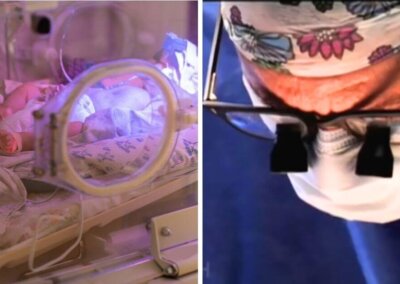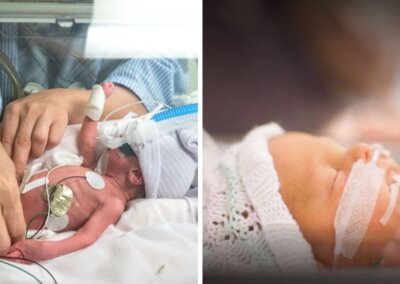The smallest baby ever to be born at a hospital in Chicago and weighing only 1lb has been discharged after spending nearly six months there receiving care.
Baby Nyla was born at just 22 weeks gestation after her mother Nakeya was diagnosed with pre-eclampsia during her pregnancy.
“It was a very scary time”, Nakeya said at a news conference for Nyla’s release from hospital.
Nyla was given a 10% chance of survival at birth. Dr Corryn Greenwood, medical director of the neonatal intensive care unit at the hospital, said “Her tiny lungs were very underdeveloped and her skin was thin and translucent”.
“Came out fighting”
Despite her being born so prematurely, Baby Nyla was a fighter from the very beginning. She “cried at birth. It was a little whimper, but it was a cry. Her heart remained over 100, which for us is where we wanted it to be. So she came out fighting right off the bat”,said neonatologist Dr Mario Sanchez.
Dr Greenwood said Nyla became more unwell during the first few weeks and months after she was born, but then, with the assistance of the dedicated staff at the hospital, was “able to get through those trying times”.
A crowd of supporters gathered outside the hospital to celebrate Nyla when she was able to return home after nearly six months.
“Everyone’s ready to celebrate this little one for sure”, Nakeya said.
“I just don’t have the words in all honesty. We’re just super grateful that she’s here, she’s healthy and she’s doing amazing”.
Survival rates have improved for babies born below the abortion limit
At just 22 weeks gestation, Nyla was born below the current UK abortion limit of 24 weeks. The last time the abortion limit was lowered in 1990, the improved survival rates for extremely prematurely born babies was one of the key considerations that motivated this change.
By the same logic, and informed by the improved survival rates for babies born at 22 and 23 weeks gestation, the abortion time limit should also be lowered now.
Key studies in recent years have documented the improving outcomes for these babies.
A 2008 study looking at survival rates for a neonatal intensive care unit in London found that neonatal survival rates at 22 and 23 weeks gestation had improved over time. In 1981-85, no babies who were born at these gestational ages survived to discharge. However, by 1986-90, 19% did and this increased to 54% in the period 1996-2000.
In the decade to 2019 alone, the survival rate for extremely premature babies born at 23 weeks doubled, prompting new guidance from the British Association of Perinatal Medicine (BAPM) that enables doctors to intervene to save premature babies from 22 weeks gestation. The previous clinical guidance, drafted in 2008, set the standard that babies who were born before 23 weeks gestation should not be resuscitated.
Research published in November 2023 by academics at the University of Leicester and Imperial College London found a total of 261 babies born alive at 22 and 23 weeks, before the abortion limit, who survived to discharge from hospital in 2020 and 2021. This is compared to the Government abortion statistics, which show that in 2021 alone, 755 abortions were performed under Section 1(1)(a) of the Abortion Act when the baby was at 22 or 23 weeks gestation (the vast majority of abortions are permitted under Section 1(1)(a) of the Abortion Act, for which there is currently a 24-week time limit).
Spokesperson for Right To Life UK, Catherine Robinson, said “How amazing to see such a crowd of supporters out to celebrate baby Nyla’s departure from hospital after such a fight for survival. Babies like Nyla are a testament to the humanity of the unborn child, who are not really any different to the babies born at 22 weeks. Legislators should take notice of these stories when considering changes to the law around abortion”.












